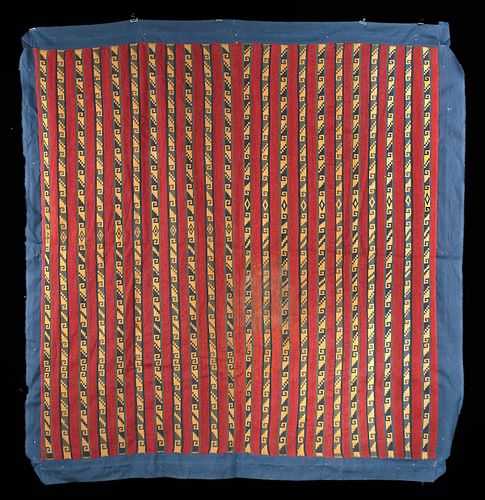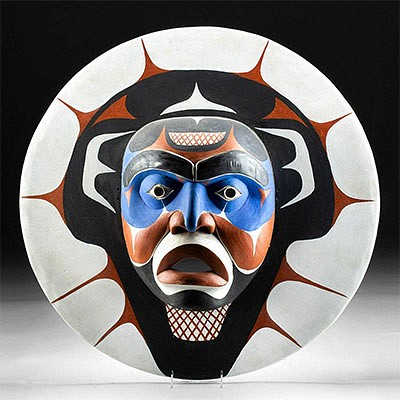Huge Inca Polychrome Textile Panel
Lot 16g
About Seller
Artemis Fine Arts
686 S Taylor Ave, Ste 106
Louisville, CO 80027
United States
Selling antiquities, ancient and ethnographic art online since 1993, Artemis Gallery specializes in Classical Antiquities (Egyptian, Greek, Roman, Near Eastern), Asian, Pre-Columbian, African / Tribal / Oceanographic art. Our extensive inventory includes pottery, stone, metal, wood, glass and textil...Read more
Estimate:
$10,000 - $15,000
Absentee vs Live bid
Two ways to bid:
- Leave a max absentee bid and the platform will bid on your behalf up to your maximum bid during the live auction.
- Bid live during the auction and your bids will be submitted real-time to the auctioneer.
Bid Increments
| Price | Bid Increment |
|---|---|
| $0 | $25 |
| $300 | $50 |
| $1,000 | $100 |
| $2,000 | $250 |
| $5,000 | $500 |
| $10,000 | $1,000 |
| $20,000 | $2,500 |
| $50,000 | $5,000 |
| $100,000 | $10,000 |
| $200,000 | $20,000 |
About Auction
By Artemis Fine Arts
Mar 18, 2021
Set Reminder
2021-03-18 10:00:00
2021-03-18 10:00:00
America/New_York
Bidsquare
Bidsquare : Pre-Columbian | Tribal | Oceanic
https://www.bidsquare.com/auctions/artemis-gallery/pre-columbian-tribal-oceanic-6520
Featuring Pre-Columbian, Native American, African / Tribal, Oceanic, much more. All items have been legally acquired and are legal to sell. Convenient in-house shipping. Artemis Fine Arts info@artemisgallery.com
Featuring Pre-Columbian, Native American, African / Tribal, Oceanic, much more. All items have been legally acquired and are legal to sell. Convenient in-house shipping. Artemis Fine Arts info@artemisgallery.com
- Lot Description
Pre-Columbian, Peru, Inca, ca. 1400 to 1532 CE. A colossal textile comprised of tightly woven camelid (alpaca or llama wool) threads in hues of crimson, olive green, midnight blue, and wheat. The sizable composition is formed from two identical panels joined at the vertical midsection. Each half of the textile bears eleven vertical blue-and-beige columns outlined with green stripes, each containing repeating decorative programs of inversely corresponding stepped, spiral, and diamond-form motifs. Gargantuan textile panels like this example were used as burial wraps for deceased individuals, though these conjoined panels were also perhaps intended for a tunic, poncho, or other article of clothing. A fabulous and colorful example of skillful Inca textile artistry. Mounted atop a museum-quality display fabric. Size (textile): 56.4" W x 55.8" H (143.3 cm x 141.7 cm); (display fabric): 62" W x 63.125" H (157.5 cm x 160.3 cm)
For an example of an Inca tunic with a similar vertical columnar motif, please see The Metropolitan Museum of Art, accession number 2005.288.
For an Inca textile fragment containing stylistically similar motifs, please see The Metropolitan Museum of Art, accession number 1987.394.727.
Provenance: private Honolulu, Hawaii, USA collection, acquired in the 1980s from William Siegal Gallery, Santa Fe, New Mexico, USA
All items legal to buy/sell under U.S. Statute covering cultural patrimony Code 2600, CHAPTER 14, and are guaranteed to be as described or your money back.
A Certificate of Authenticity will accompany all winning bids.
We ship worldwide and handle all shipping in-house for your convenience.
#153551Both panels of this textile were joined in the middle in modern times with red thread but were likely conjoined or part of the same textile composition when created. Minor fraying to some peripheral threads, with light staining, and minor creasing, otherwise intact and choice. Wonderful remains of original coloration throughout.Condition
- Shipping Info
-
All shipping is handled in-house for your convenience. Your invoice from Artemis Gallery will include shipping calculation instructions. If in doubt, please inquire BEFORE bidding for estimated shipping costs for individual items.
-
- Buyer's Premium



 EUR
EUR CAD
CAD AUD
AUD GBP
GBP MXN
MXN HKD
HKD CNY
CNY MYR
MYR SEK
SEK SGD
SGD CHF
CHF THB
THB















